优选中国四大菜系英文介绍
- 格式:ppt
- 大小:9.67 MB
- 文档页数:30
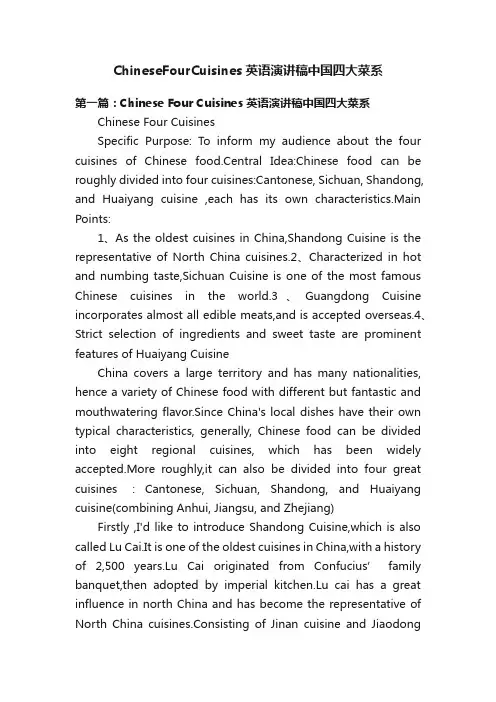
ChineseFourCuisines英语演讲稿中国四大菜系第一篇:Chinese Four Cuisines 英语演讲稿中国四大菜系Chinese Four CuisinesSpecific Purpose: To inform my audience about the four cuisines of Chinese food.Central Idea:Chinese food can be roughly divided into four cuisines:Cantonese, Sichuan, Shandong, and Huaiyang cuisine ,each has its own characteristics.Main Points:1、As the oldest cuisines in China,Shandong Cuisine is the representative of North China cuisines.2、Characterized in hot and numbing taste,Sichuan Cuisine is one of the most famous Chinese cuisines in the world.3、Guangdong Cuisine incorporates almost all edible meats,and is accepted overseas.4、Strict selection of ingredients and sweet taste are prominent features of Huaiyang CuisineChina covers a large territory and has many nationalities, hence a variety of Chinese food with different but fantastic and mouthwatering flavor.Since China's local dishes have their own typical characteristics, generally, Chinese food can be divided into eight regional cuisines, which has been widely accepted.More roughly,it can also be divided into four great cuisines :Cantonese, Sichuan, Shandong, and Huaiyang cuisine(combining Anhui, Jiangsu, and Zhejiang)Firstly ,I'd like to introduce Shandong Cuisine,which is also called Lu Cai.It is one of the oldest cuisines in China,with a history of 2,500 years.Lu Cai originated from Confucius’ family banquet,then adopted by imperial kitchen.Lu cai has a great influence in north China and has become the representative of North China cuisines.Consisting of Jinan cuisine and Jiaodongcuisine, Shandong cuisine, clear, pure and not greasy, is characterized by its emphasis on aroma, freshness, crispness.Shallot and garlic are usually used as seasonings so Shangdong dishes usually tastes pungent.It specializes in seafood like prawns, sea cucumber.Soups are given much emphasis in Shangdong dishes.Thin soup features clear and fresh while creamy soup looks thick and tastes strong.The next one is Sichuan Cuisine,which is one of the fastest growing cuisines in the world.Learning from other cuisines and cooking in its own style makes Sichuan Cuisine one of the most famous Chinese cuisines in the world.It is characterized in hot and numbing taste by using a lot of peppercorns and spices.Pepper and prickly ash also never fail to accompany, producing typical exciting tastes.Wild vegetables and animals are usually chosen as ingredients.It is said that one who doesn't experience Sichuan food never reaches China.Now,what is showed is Guangdong Cuisine.Nowadays, most Chinese restaurants overseas serve mainly Cantonese food.Cantonese cuisine incorporates almost all edible meats, including organ meats, chicken feet, duck and duck tongues, snakes, and snails.Freshest and quality ingredients are crucial.Spices should be used in modest amounts to avoid overwhelming the flavors of the primary ingredients.Here is Huaiyang Cuisine.Huaiyang Cuisine has strict selection of ingredients according to seasons.It used to be expensive and luxury.Sweet is the most prominent feature of Huaiyang Cuisine, nearly not spicy at all.And cutting of the material is the key factor for a good dish.Pork, fresh water fish, and other aquatic creatures serve as the meat base to most dishes.These are the Four Great cuisines of Chinese food.I hope the informations are useful for you.Thank you for your listening!第二篇:《四大菜系》教学设计[范文模版]《四大菜系》教学设计阳信县金阳街道中心小学曹云英《四大菜系》是齐鲁书社版《传统文化》五年级下册饮食文化单元中的第三课,主要介绍中国的菜系文化内容,通过学习让学生了解掌握中国的四大菜系,欣赏中国饮食文化的特点,同时通过本课的学习感受中国饮食文化的博大精深,进一步激发学生探索饮食文化的兴趣。
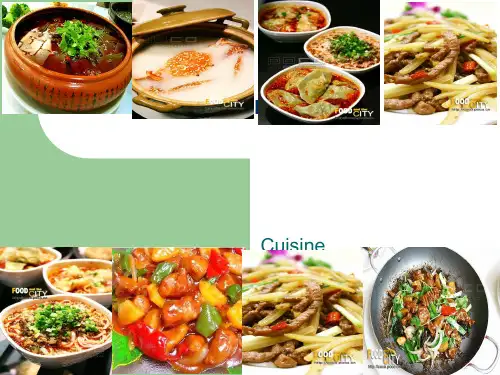
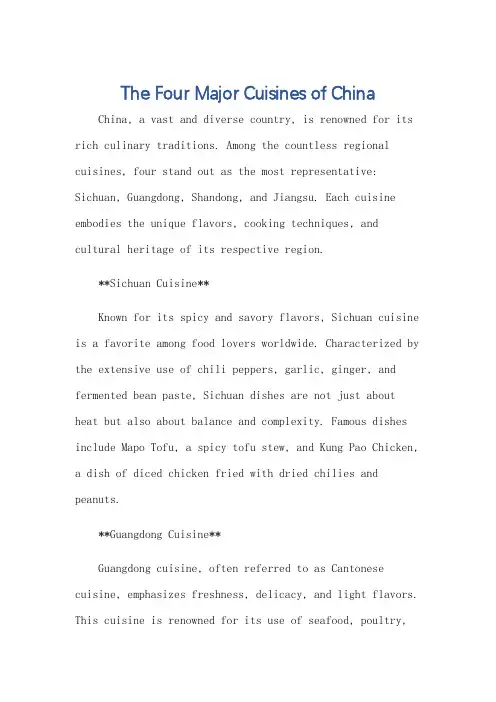
The Four Major Cuisines of ChinaChina, a vast and diverse country, is renowned for its rich culinary traditions. Among the countless regional cuisines, four stand out as the most representative: Sichuan, Guangdong, Shandong, and Jiangsu. Each cuisine embodies the unique flavors, cooking techniques, and cultural heritage of its respective region.**Sichuan Cuisine**Known for its spicy and savory flavors, Sichuan cuisine is a favorite among food lovers worldwide. Characterized by the extensive use of chili peppers, garlic, ginger, and fermented bean paste, Sichuan dishes are not just about heat but also about balance and complexity. Famous dishes include Mapo Tofu, a spicy tofu stew, and Kung Pao Chicken, a dish of diced chicken fried with dried chilies and peanuts.**Guangdong Cuisine**Guangdong cuisine, often referred to as Cantonese cuisine, emphasizes freshness, delicacy, and light flavors. This cuisine is renowned for its use of seafood, poultry,and vegetables, often cooked with minimal seasoning toallow the natural flavors of the ingredients to shine. Dim Sum, the iconic small, steamed buns filled with various fillings, is a prime example of Guangdong cuisine's finesse and creativity.**Shandong Cuisine**Shandong, or Lu cuisine, is known for its emphasis on soup-making and seafood. This cuisine, influenced by Confucianism, values harmony and balance in its dishes. Shandong chefs are masters of cooking techniques such as braising and stewing, resulting in dishes that are rich in flavor and texture. A typical Shandong dish is the Braised Chicken with Brown Sauce, a dish that showcases thecuisine's skill in balancing sweet, savory, and umami flavors.**Jiangsu Cuisine**Jiangsu cuisine, often referred to as Su cuisine, is renowned for its sweet and delicate flavors. This cuisine, influenced by the rich waterways of the Yangtze River, features an abundance of seafood and freshwater fish dishes. Chefs in Jiangsu are masters of precision cooking,resulting in dishes that are both visually appealing and flavorful. A classic example is the Red-Braised Pork Belly, a dish that combines sweet, savory, and umami flavors in a lush, succulent texture.In conclusion, the four major cuisines of China each offer a unique and delicious taste of the country's rich cultural heritage. From the spicy heat of Sichuan to the freshness of Guangdong, the balance of Shandong, and the sweetness of Jiangsu, these cuisines offer a diverse and delicious palette of flavors that are truly representative of China's vast and diverse culinary traditions.**中国四大菜系**中国,这个广阔而多元的国家,因其丰富的烹饪传统而闻名于世。
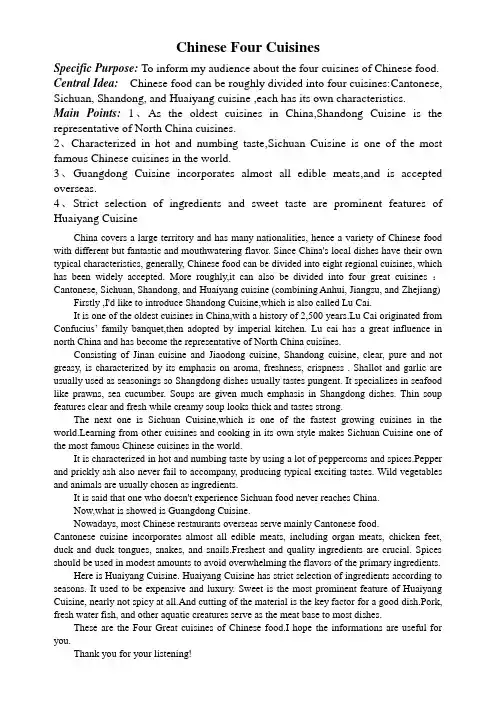
Chinese Four CuisinesSpecific Purpose: To inform my audience about the four cuisines of Chinese food. Central Idea: Chinese food can be roughly divided into four cuisines:Cantonese, Sichuan, Shandong, and Huaiyang cuisine ,each has its own characteristics.Main Points: 1、As the oldest cuisines in China,Shandong Cuisine is the representative of North China cuisines.2、Characterized in hot and numbing taste,Sichuan Cuisine is one of the most famous Chinese cuisines in the world.3、Guangdong Cuisine incorporates almost all edible meats,and is accepted overseas.4、Strict selection of ingredients and sweet taste are prominent features of Huaiyang CuisineChina covers a large territory and has many nationalities, hence a variety of Chinese food with different but fantastic and mouthwatering flavor. Since China's local dishes have their own typical characteristics, generally, Chinese food can be divided into eight regional cuisines, which has been widely accepted. More roughly,it can also be divided into four great cuisines :Cantonese, Sichuan, Shandong, and Huaiyang cuisine (combining Anhui, Jiangsu, and Zhejiang) Firstly ,I'd like to introduce Shandong Cuisine,which is also called Lu Cai.It is one of the oldest cuisines in China,with a history of 2,500 years.Lu Cai originated from Confucius’ family banquet,then adopted by imperial kitchen. Lu cai has a great influence in north China and has become the representative of North China cuisines.Consisting of Jinan cuisine and Jiaodong cuisine, Shandong cuisine, clear, pure and not greasy, is characterized by its emphasis on aroma, freshness, crispness . Shallot and garlic are usually used as seasonings so Shangdong dishes usually tastes pungent. It specializes in seafood like prawns, sea cucumber. Soups are given much emphasis in Shangdong dishes. Thin soup features clear and fresh while creamy soup looks thick and tastes strong.The next one is Sichuan Cuisine,which is one of the fastest growing cuisines in the world.Learning from other cuisines and cooking in its own style makes Sichuan Cuisine one of the most famous Chinese cuisines in the world.It is characterized in hot and numbing taste by using a lot of peppercorns and spices.Pepper and prickly ash also never fail to accompany, producing typical exciting tastes. Wild vegetables and animals are usually chosen as ingredients.It is said that one who doesn't experience Sichuan food never reaches China.Now,what is showed is Guangdong Cuisine.Nowadays, most Chinese restaurants overseas serve mainly Cantonese food.Cantonese cuisine incorporates almost all edible meats, including organ meats, chicken feet, duck and duck tongues, snakes, and snails.Freshest and quality ingredients are crucial. Spices should be used in modest amounts to avoid overwhelming the flavors of the primary ingredients.Here is Huaiyang Cuisine. Huaiyang Cuisine has strict selection of ingredients according to seasons. It used to be expensive and luxury. Sweet is the most prominent feature of Huaiyang Cuisine, nearly not spicy at all.And cutting of the material is the key factor for a good dish.Pork, fresh water fish, and other aquatic creatures serve as the meat base to most dishes.These are the Four Great cuisines of Chinese food.I hope the informations are useful for you.Thank you for your listening!。
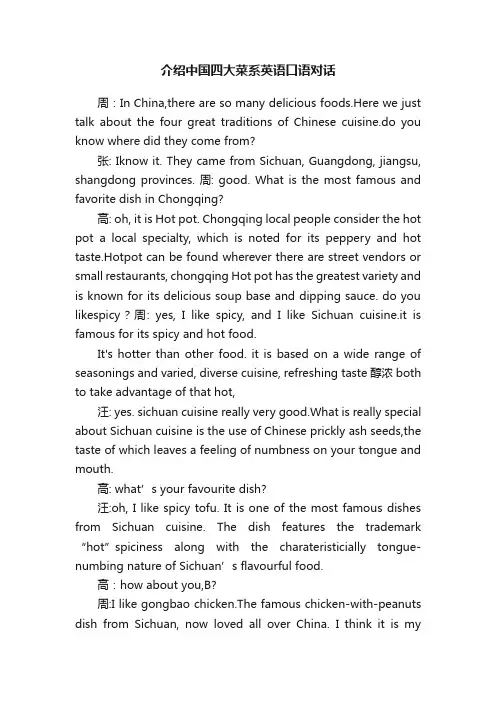
介绍中国四大菜系英语口语对话周:In China,there are so many delicious foods.Here we just talk about the four great traditions of Chinese cuisine.do you know where did they come from?张: Iknow it. They came from Sichuan, Guangdong, jiangsu, shangdong provinces. 周: good. What is the most famous and favorite dish in Chongqing?高: oh, it is Hot pot. Chongqing local people consider the hot pot a local specialty, which is noted for its peppery and hot taste.Hotpot can be found wherever there are street vendors or small restaurants, chongqing Hot pot has the greatest variety and is known for its delicious soup base and dipping sauce. do you likespicy?周: yes, I like spicy, and I like Sichuan cuisine.it is famous for its spicy and hot food.It's hotter than other food. it is based on a wide range of seasonings and varied, diverse cuisine, refreshing taste醇浓both to take advantage of that hot,汪: yes. sichuan cuisine really very good.What is really special about Sichuan cuisine is the use of Chinese prickly ash seeds,the taste of which leaves a feeling of numbness on your tongue and mouth.高: what’s your favourite dish?汪:oh, I like spicy tofu. It is one of the most famous dishes from Sichuan cuisine. The dish features the trademark “hot”spiciness along with the charateristicially tongue-numbing nature of Sichuan’s flavourful food.高:how about you,B?周:I like gongbao chicken.The famous chicken-with-peanuts dish from Sichuan, now loved all over China. I think it is myfavorite Chinese dish! Still, not easy to get those flavours right - it should be spicy, hot, numbing, garlicky , gingery and sweet, all at the same time!王: oh ,sichuan cuisine is too spicy for me. I like a little light food. Zhejiang cuisine is light and exquisite, and is typical of food form along the lower Yangtze river.One famous dish is west lake vinegar fish, which looks pretty and has the delicate refreshing flavors of nature.刘: I know another famous dish in zhengjiang cuisine. It is called dongpo meat. This dish of streaky pork is prepared over a slow fire where the big chunks of pork are braised with green onion, ginger, cooking wine, soy sauce, and suger.Thefinished dish is bright red in color and the meat is tender and juicy.王, you are form Shandong province. Cloud you give us an introduction of Shandong cuisine?张: ok, Shandong cuisine is clear, pure and not greasy. Shallot and garlic are usually used as seasonings so Shandong dishes tastes pungent usually. Soups are given much emphasis in Shandong dishes. Thin soup features clear and fresh while creamy soup looks thick and tastes strong.刘: I have been to Shandong. Shandong's most famous dish is the Sweat and Sour Carp. Shandong dishes are mainly quick-fried, roasted, stir-fried or deep-fried.The dishes are mainly clear, fresh and fatty, perfect with Shandong's own famous beer, Qingdao Beer.高:at last, I will talk about Guangzhou cuisine, it features light and fresh with a clear and fragrant smell. Light foods are served in summer and autumn, and strong foods in winter and spring.张:by the way, When you are in guangzhou. You cannot miss the nutritious and healthy slow-cooked soup, which takes five or six hours to cook.。
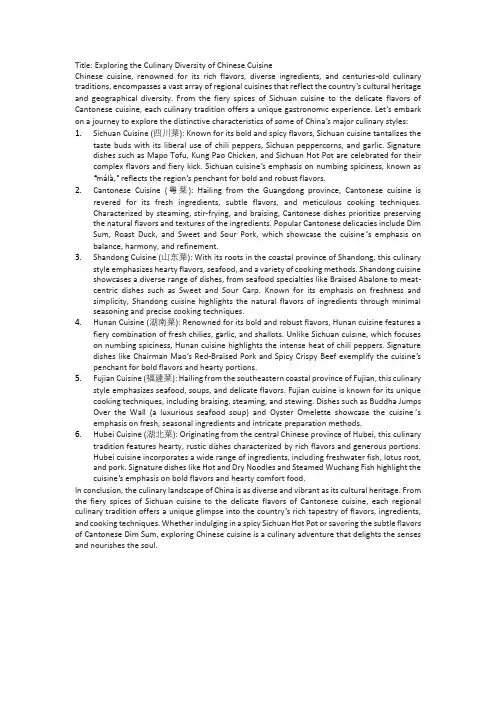
Title: Exploring the Culinary Diversity of Chinese CuisineChinese cuisine, renowned for its rich flavors, diverse ingredients, and centuries-old culinary traditions, encompasses a vast array of regional cuisines that reflect the country’s cultural heritage and geographical diversity. From the fiery spices of Sichuan cuisine to the delicate flavors of Cantonese cuisine, each culinary tradition offers a unique gastronomic experience. Let’s embark on a journey to explore the distinctive characteristics of some of China’s major culinary styles: 1.Sichuan Cuisine (四川菜): Known for its bold and spicy flavors, Sichuan cuisine tantalizes thetaste buds with its liberal use of chili peppers, Sichuan peppercorns, and garlic. Signature dishes such as Mapo Tofu, Kung Pao Chicken, and Sichuan Hot Pot are celebrated for their complex flavors and fiery kick. Sichuan cuisine’s emphasis on numbing spiciness, known as “málà,” reflects the region’s penchant for bold and robust flavors.2.Cantonese Cuisine (粤菜): Hailing from the Guangdong province, Cantonese cuisine isrevered for its fresh ingredients, subtle flavors, and meticulous cooking techniques.Characterized by steaming, stir-frying, and braising, Cantonese dishes prioritize preserving the natural flavors and textures of the ingredients. Popular Cantonese delicacies include Dim Sum, Roast Duck, and Sweet and Sour Pork, which showcase the cuisine’s emphasis on balance, harmony, and refinement.3.Shandong Cuisine (山东菜): With its roots in the coastal province of Shandong, this culinarystyle emphasizes hearty flavors, seafood, and a variety of cooking methods. Shandong cuisine showcases a diverse range of dishes, from seafood specialties like Braised Abalone to meat-centric dishes such as Sweet and Sour Carp. Known for its emphasis on freshness and simplicity, Shandong cuisine highlights the natural flavors of ingredients through minimal seasoning and precise cooking techniques.4.Hunan Cuisine (湖南菜): Renowned for its bold and robust flavors, Hunan cuisine features afiery combination of fresh chilies, garlic, and shallots. Unlike Sichuan cuisine, which focuses on numbing spiciness, Hunan cuisine highlights the intense heat of chili peppers. Signature dishes like Chairman Mao’s Red-Braised Pork and Spicy Crispy Beef exemplify the cuisine’s penchant for bold flavors and hearty portions.5.Fujian Cuisine (福建菜): Hailing from the southeastern coastal province of Fujian, this culinarystyle emphasizes seafood, soups, and delicate flavors. Fujian cuisine is known for its unique cooking techniques, including braising, steaming, and stewing. Dishes such as Buddha Jumps Over the Wall (a luxurious seafood soup) and Oyster Omelette showcase the cuisine’s emphasis on fresh, seasonal ingredients and intricate preparation methods.6.Hubei Cuisine (湖北菜): Originating from the central Chinese province of Hubei, this culinarytradition features hearty, rustic dishes characterized by rich flavors and generous portions.Hubei cuisine incorporates a wide range of ingredients, including freshwater fish, lotus root, and pork. Signature dishes like Hot and Dry Noodles and Steamed Wuchang Fish highlight the cuisine’s emphasis on bold flavors and hearty comfort food.In conclusion, the culinary landscape of China is as diverse and vibrant as its cultural heritage. From the fiery spices of Sichuan cuisine to the delicate flavors of Cantonese cuisine, each regional culinary tradition offers a unique glimpse into the country’s rich tapestry of flavors, ingredients, and cooking techniques. Whether indulging in a spicy Sichuan Hot Pot or savoring the subtle flavors of Cantonese Dim Sum, exploring Chinese cuisine is a culinary adventure that delights the senses and nourishes the soul.。
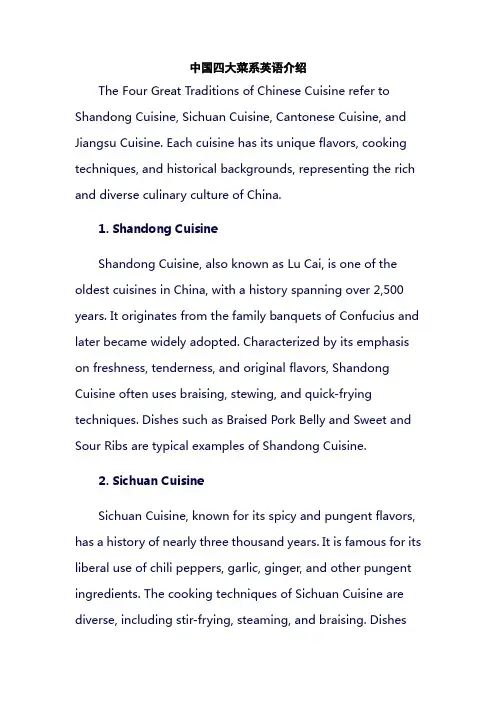
中国四大菜系英语介绍The Four Great Traditions of Chinese Cuisine refer to Shandong Cuisine, Sichuan Cuisine, Cantonese Cuisine, and Jiangsu Cuisine. Each cuisine has its unique flavors, cooking techniques, and historical backgrounds, representing the rich and diverse culinary culture of China.1. Shandong CuisineShandong Cuisine, also known as Lu Cai, is one of the oldest cuisines in China, with a history spanning over 2,500 years. It originates from the family banquets of Confucius and later became widely adopted. Characterized by its emphasis on freshness, tenderness, and original flavors, Shandong Cuisine often uses braising, stewing, and quick-frying techniques. Dishes such as Braised Pork Belly and Sweet and Sour Ribs are typical examples of Shandong Cuisine.2. Sichuan CuisineSichuan Cuisine, known for its spicy and pungent flavors, has a history of nearly three thousand years. It is famous for its liberal use of chili peppers, garlic, ginger, and other pungent ingredients. The cooking techniques of Sichuan Cuisine are diverse, including stir-frying, steaming, and braising. Disheslike Mapo Tofu, Spicy Chicken, and Fish Fragrant Prawns are all representative of Sichuan Cuisine's unique flavors.3. Cantonese CuisineCantonese Cuisine, originating in Guangdong Province, is renowned for its light and delicate flavors. It emphasizes the freshness and original taste of ingredients, often using steaming, stir-frying, and roasting techniques. Cantonese Cuisine is also known for its innovative use of seafood and its meticulous preparation methods. Dishes like Roast Goose, Dim Sum, and Steamed Fish with Ginger and Scallions are typical examples of Cantonese Cuisine.4. Jiangsu CuisineJiangsu Cuisine, also known as Su Cai, is known for its emphasis on freshness, tenderness, and original flavors. It often uses light seasonings and cooking techniques such as steaming, stewing, and braising to preserve the natural flavors of the ingredients. Dishes like Lion's Head Meatballs, Crab Meat Soup, and Sweet and Sour Pork Ribs are representative of Jiangsu Cuisine's delicate and refreshing flavors.In conclusion, the Four Great Traditions of Chinese Cuisine each have their unique characteristics and flavors, reflecting the rich and diverse culinary culture of China. Whether you prefer the freshness and tenderness of Shandong Cuisine, the spicy and pungent flavors of Sichuan Cuisine, the light and delicate flavors of Cantonese Cuisine, or the refreshing and delicate flavors of Jiangsu Cuisine, there is sure to be a dish that will satisfy your taste buds.。
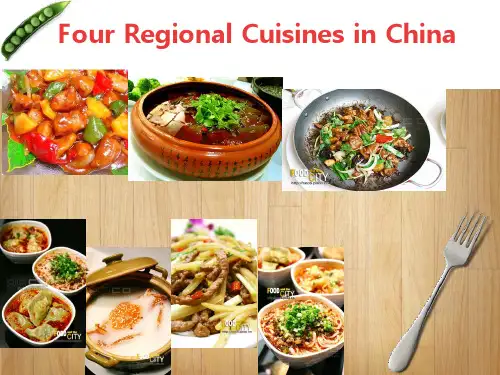
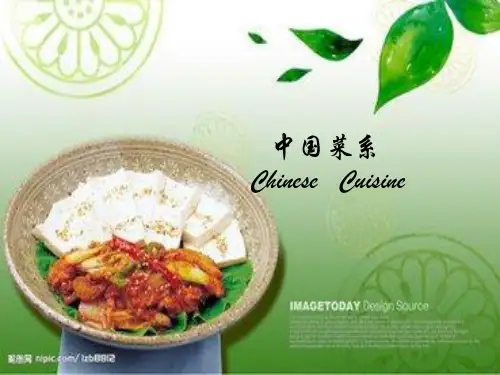

介绍中国八大菜系的英语作文Chinese cuisine is known for its diversity and rich flavors, with eight major regional cuisines that showcase the country's culinary heritage. Let's take a closer look at each of these eight major Chinese cuisines:1. Cantonese cuisine:Cantonese cuisine, also known as Yue cuisine, originates from the Guangdong province in southern China. It is characterized by its delicate and fresh flavors, as well as its emphasis on seafood and stir-frying techniques. Popular dishes include dim sum, sweet and sour pork, and wonton soup.2. Sichuan cuisine:Sichuan cuisine, hailing from the Sichuan province in southwestern China, is famous for its bold and spicy flavors. The liberal use of garlic, chili peppers, and Sichuan peppercorns gives Sichuan dishes their distinctive numbing and spicy taste. Popular dishes include mapo tofu, kung pao chicken, and hot pot.3. Shandong cuisine:Shandong cuisine, also known as Lu cuisine, comes from the Shandong province in eastern China. It is known for its emphasis on seafood and the use of light, savory flavors. Shandong dishes often feature braising, deep-frying, and quick-frying techniques. Popular dishes include sweet and sour carp, braised abalone, and fried sea cucumber.4. Jiangsu cuisine:Jiangsu cuisine, originating from the Jiangsu provincein eastern China, is known for its delicate and light flavors. It emphasizes the freshness and seasonality of ingredients, as well as the meticulous presentation of dishes. Popular dishes include squirrel-shaped mandarin fish, lion's head meatballs, and salted duck.5. Zhejiang cuisine:Zhejiang cuisine, also known as Zhe cuisine, comes from the Zhejiang province in eastern China. It is characterized by its fresh and tender flavors, as well as its emphasis on seafood and bamboo shoots. Zhejiang dishes often feature steaming, braising, and stewing techniques. Popular dishes include Dongpo pork, West Lake vinegar fish, and beggar's chicken.6. Hunan cuisine:Hunan cuisine, originating from the Hunan province in central China, is known for its bold and spicy flavors. It is similar to Sichuan cuisine but is less numbing and more aromatic. Popular dishes include Chairman Mao's red-braised pork, steamed fish head with chopped chili, and stir-fried pork with smoked tofu.7. Fujian cuisine:Fujian cuisine, coming from the Fujian province in southeastern China, is known for its emphasis on seafood and umami-rich flavors. It features a wide variety of ingredients, including seafood, mushrooms, and bamboo shoots. Popular dishes include Buddha Jumps Over the Wall, oyster omelette, and fish ball soup.8. Anhui cuisine:Anhui cuisine, originating from the Anhui province in eastern China, is known for its use of wild herbs and game meats. It emphasizes braising, stewing, and slow-cooking techniques to bring out the natural flavors of theingredients. Popular dishes include braised turtle with ham, salt-baked chicken, and bamboo shoots with pork belly.中国菜系以其多样性和丰富的口味而闻名,有八大主要菜系展示了该国的烹饪传统。
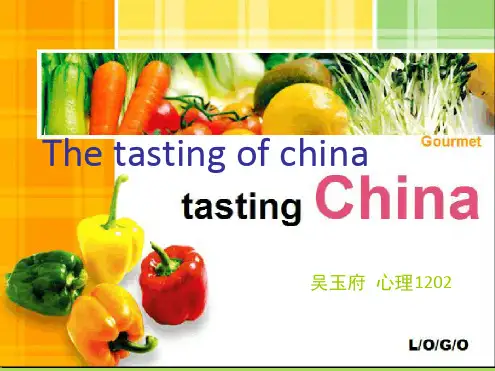
中国的菜系英语作文Chinese cuisine is renowned worldwide for its rich flavors, diverse ingredients, and unique cooking techniques. China's vast geography and long history have led to the development of various regional cuisines, each with its own distinct characteristics and flavors.The four major culinary traditions are Shandong, Sichuan, Cantonese, and Jiangsu cuisines, each representing adifferent part of China and showcasing a unique culinary style.Shandong Cuisine: Originating from the eastern coastal province of Shandong, this cuisine is known for its emphasis on seafood and the use of fresh ingredients. Dishes are typically light, with a focus on the natural flavors of the food. A famous dish from this region is "Sweet and Sour Carp," which is a symbol of good luck and prosperity.Sichuan Cuisine: Sichuan, located in the southwest, is famous for its bold flavors, particularly the liberal use of chili peppers and Sichuan peppercorns. The cuisine is known for its "numbing and spicy" taste, which is a result of the peppercorns' unique flavor. "Mapo Tofu" and "Kung Pao Chicken" are two popular dishes that exemplify the boldness of Sichuan cuisine.Cantonese Cuisine: From the southern province of Guangdong,Cantonese cuisine is characterized by its lightness and freshness. It is also known for its dim sum, which is a style of eating that involves a variety of small, bite-sized dishes. "Char Siu" (barbecued pork) and "Siu Mai" (steamed dumplings) are some of the many delicacies that Cantonese cuisine offers.Jiangsu Cuisine: This style, from the lower Yangtze River region, is known for its delicate flavors and meticulous preparation. The dishes are often sweet and savory, with a focus on the balance of flavors. "Dongpo Pork" and "Nanjing Salted Duck" are two examples of the region's famous dishes.In addition to these four major cuisines, there are manyother regional styles, such as Hunan, Fujian, Anhui, and Zhejiang cuisines, each with its own unique dishes and flavors.Chinese cuisine is not just about the food; it is also about the culture and the art of eating. Meals are often a time for families to come together, and food is often used as a way to express hospitality and generosity. The Chinese believe that food is not only for sustenance but also for enjoyment andfor maintaining health.In conclusion, Chinese cuisine is a rich tapestry of flavors and traditions that reflects the diversity and history of China. Whether you are a fan of the spicy kick of Sichuan,the delicate flavors of Jiangsu, or the fresh seafood of Shandong, there is something for everyone in the world of Chinese cuisine.。